
 |
|
|
The Call of the Wild: Into the Wild Debunked“Rather than love, than money, than fame, give me truth.” Filmmaker's note: In the summer of 1992, while living in an abandoned bus on Alaska's Stampede Trail, Chris McCandless highlighted the above passage from Walden, and wrote TRUTH at the top of the page. These words held personal meaning for McCandless, but they also represent the kind of moral absolutism he both preached and practiced. Chris is no longer with us, but I can't help but wonder what he would think about the current state of his biography—Into the Wild—both written and cinematic versions of his life that seem to have turned Thoreau's dictum on its head. I do not intend herein to engage in the sort of nitpicking often found in these types of critiques. Whether McCandless took a canoe or kayak down the Colorado River is not that important in the final analysis. Some artistic license is to be expected in a film such as Into the Wild; indeed, it could be argued that such a scene evokes Herzog's "ecstatic truth," the kind that transcends the facts involved. Likewise, even the best nonfiction writer will sometimes make harmless and/or unintentional mistakes. Rather, I feel compelled to discuss a fiction that in my mind does meet the threshold of mattering—the cause of Chris's death—and to detail how the truth about it was ignored, and then the fiction re-invented, for the sake of reputation, and ultimately, dramatic effect. By doing so it is not my intention to slight Chris McCandless in the least, and I regret that any of these findings might be used insensitively or without proper context by the "anti-McCandless" camp. I am not—and it has never been my intention to be—a critic of Chris McCandless and the choices he made (see BACKSTORY). In fact, as stated on the documentary's home page, The Call of the Wild is most of all a celebration of the spirit of McCandless, and a reflection on his legacy—not some sort of expose. Be that as it may, and equally in the spirit of McCandless-via-Thoreau, here are three truths (and one speculation): I. Chris McCandless did not die as the result of eating a poisonous plant or "moldy seeds."
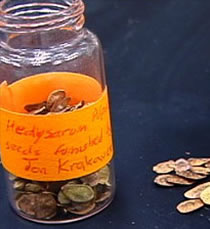 H. alpinum seeds provided to
Dr. Clausen by Jon Krakauer As for the most recent Jon Krakauer "epiphany" about moldy seeds, hurriedly put forth in the wake of a September 2007 Men's Journal article ("The Cult of Chris McCandless") that for the first time in the Lower 48 revealed the falsehood of the H. alpinum theory, it is once again an untested theory, and one based entirely on veterinary literature—an obscure case where some horses in North Carolina ate large quantities of moldy red clover hay. He provides no evidence in support of the idea that this particular mold (Rhizoctonia leguminicola) has been found in Alaska on Hedysarum alpinum plants and linked with swainsonine. Nor can he provide a single case where a human has ever, anywhere, been poisoned in this way. And yet, Krakauer speaks of it in public as if this were a proven fact: "It turned out—I've learned, since writing the book, those seeds were moldy. And this mold created a poison that doesn't actually kill you outright, it keeps you from digesting food. So even though he was still eating food, he couldn't make use of it. And that—so he starved to death because he ate these moldy seeds" (The Oprah Winfrey Show, 9/20/07). The same day he repeated this claim on National Public Radio's "All Things Considered," describing to Melissa Block how he "puzzled" over this for years, but was now "pretty convinced" that Chris McCandless died from eating moldy potato seeds.
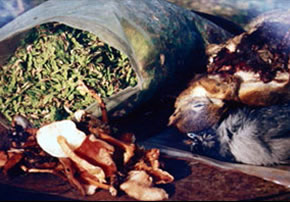 Can you see Rhizoctonia leguminicola here?
How did Krakauer "learn" that the seeds were moldy? According to his NPR interview, it was from this single photograph at right, where he says "you can see it's damp," and that it was in this Ziploc bag where the mold grew. This, of course, begs the question as to how he could possibly know from this single photo—if indeed these seeds are even moldy—that the mold produced was Rhizoctonia leguminicola, and that it was contaminated by the toxic alkaloid swainsonine. And further, that Chris then proceeded to freely eat "enormous quantities" of these moldy seeds, enough so that he was poisoned to the point where he could no longer digest any food. This theory is based on so many contingencies, and is so lacking in solid evidence, that it belies common sense. And yet, beyond this botanic minutiae, perhaps the most important question for Jon Krakauer is why—if he's "puzzled" over this for years, "doggedly" sifting through the literature, and has now come so firmly to believe in this new theory—he did not change the text of his book for the Sean Penn movie cover edition that was re-released in bookstores on August 21, 2007. Indeed, despite Dr. Clausen's 1997 findings, not a word on the subject in the movie cover version released in the third week of August 2007 had been changed from the original 1996 book. It still read: "Conclusive spectrographic analysis has yet to be completed, but preliminary testing by Clausen...indicates that the seeds definitely contains traces of an alkaloid." Not even a month later, however, these movie cover editions were quietly yanked from the shelves of bookstores all across America and replaced with a hastily printed revised edition that put forth the new moldy seed hypothesis. The so-called epiphany, it seems, had more to do with Matthew Power's Men's Journal article, when the decade-long deception was finally revealed, than anything else. There's something moldy, all right, but it's not the seeds—it's the theory that Chris McCandless's death was caused by a plant he ate. Filmmaker update: Recently, an Alaskan high school student under the guidance of Dr. Clausen conducted a science experiment where he "sought to find evidence for whether or not H. alpinum seeds can produce swainsonine when grown with naturally occurring fungi." In the end, after repeated failed attempts to find any detectable levels of the toxic alkaloid swainsonine in the samples, it was concluded that there was "no evidence to support the hypothesis that a fungus growing on H. alpinum seeds can produce swainsonine." II. There's no need to create far-fetched theories about toxic mold. It's a case of Ockham's razor: Chris McCandless starved to death over the course of 113 days.Chris McCandless's Body Mass Index (BMI) was on a downward trajectory from the day he walked "into the wild," and it continued steadily downward until his death by starvation 113 days later. In all of the above Jon Krakauer and Sean Penn-formulated hypotheses, the suggestion is that McCandless was doing well during his wilderness experience and then quickly starved to death after making a costly, albeit "innocent," mistake. As everyone knows, the scientific method is a 3-step process: (1) observe the facts, (2) develop a hypothesis, and (3) test the hypothesis. Based on results, the hypothesis may need to be refined and retested, over and over again, until the results cannot be disproved. Up to now, the hypothesis on McCandless appears to be: "Since he was doing well, what caused him to die of starvation?" This, of course, begs the question: On what facts is this hypothesis based? How do we know McCandless was doing well? Photos show an ever-increasingly gaunt McCandless. By McCandless's own account, there were days of no food. And his diet was low in fats. And so perhaps the above hypothesis is flawed. By pre-determining that McCandless was doing well, simply by counting the number of birds and squirrels he was eating, Krakauer and Penn are left looking for a dramatic precipitating factor that caused his ultimate starvation. However, if one wants to identify a "scientific" cause for the death of Chris McCandless, then let's start with an appropriate hypothesis, grounded in the scientific method. We observe that McCandless died of starvation. Our hypothesis then becomes: "What was the nutritional state (or rather, the energetic state) of Chris McCandless during his 113 days in the wild?"
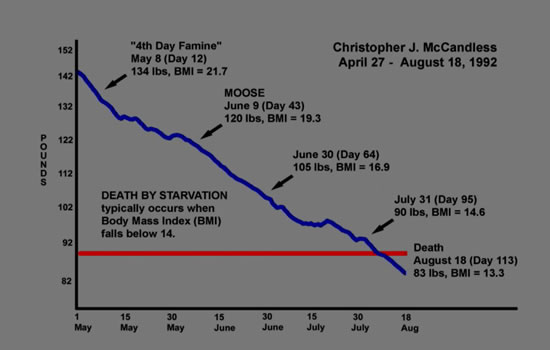 No need for a precipitating event when explaining McCandless's starvation
Using peer-reviewed scientific literature, relying on calculations developed by the World Health Organization, and informed by McCandless's own food journals, we tested this hypothesis. The result was that, despite some success hunting and gathering, McCandless was not able to secure enough food on a daily basis. He slowly lost weight until he reached a Body Mass Index (BMI) that was fatal. To test this hypothesis, we calculated his energy expenditure and compared this to his caloric intake. To assess his energy expenditure, we predicted the basal metabolic rate (BMR) of McCandless using a regression equation developed by the World Health Organization for young adult humans, age18-29. His BMR was adjusted to reflect his physical activity level—hunting and gathering—as defined by WHO criteria. McCandless's caloric intake was estimated from his detailed 113-day food journal. In the end, a day-by-day comparison of his energy expenditure (BMR) and his caloric intake showed a consistent caloric deficit, i.e. weight loss. By Day 113, his Body Mass Index (BMI) had dropped into the range of 13 kg/m2, a level considered incompatible with life. It is believed he died on that same day. This empirical analysis of McCandless's energetic state shows a steady loss of weight. He may have gotten sick from one of his meals at the end of July ("Extremely weak. Fault of pot. seed," he writes on 7/30/92), but this was not the cause of his death. The data show that he died of starvation because he couldn't meet his energetic needs over 113 days. There is no need to devise a theory based on a botany mistake, or the ingestion of "toxic seeds." To suggest, as Krakauer does, that McCandless was "hungry but doing fine" (9/20/07 NPR interview) and "in reasonably good health" (Into the Wild, p. 189), and starved only because he ingested moldy seeds is to ignore the data. However, these false explanations accomplish two things: they enable Krakauer to reprint Into the Wild without running afoul, either in terms of his original theory, or his tardiness with the facts; and second, they provide both Krakauer and Penn a dramatic device to heighten the tragic nature of the story, and a means to assert that "the guy wasn't quite as reckless and incompetent as he has been made out to be" (Into the Wild, p. 194). Ironically, it could be argued that having Chris unable to correctly identify a plant, or having him so foolish as to be eating "enormous quantities" of mold, is actually to cast him as more "reckless and incompetent" rather than less, and belies both his intelligence and toughness, and his will to live. When we spoke with the Alaskan medical examiner who conducted the Chris McCandless autopsy, and asked him if he thought Chris might have been poisoned...he said no, not at all, and that he believed McCandless simply starved to death. III. Counter to the portrayal in the Krakauer book and Penn film, Chris McCandless carried "into the wild" a wallet with multiple sources of identification and $300 in cash, as well as a map.
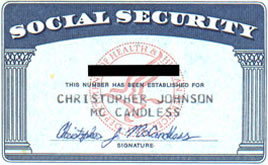 Chris did not burn his social security card
Regarding the wallet, Healy resident Will Forsberg discovered it in McCandless's backpack, that had been left out in the bus following Chris's death. Somehow the Alaska state troopers and investigators at the scene missed it. And so it now seems the two-week mystery and search for McCandless's identification, played out in newspapers all across the country, and ironically, the inspiration for much that has been said and written about him in the years that followed, was rather unnecessary. Right there in the bus with him was a wallet that contained his social security card, birth certificate, driver's license, health card, voter identification, and three library cards. Most significantly, this new evidence seems to indicate that Chris had no "death wish," as some of his harshest detractors have claimed, and that in fact he intended to return to society at some point. 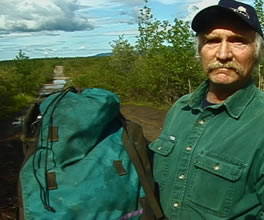 Will Forsberg found Chris's backpack in fall 1992
Why was mention of the map removed? Well, perhaps because it is listed among the possessions returned to the McCandless family following Chris's death. Curiously, however, Krakauer fails to mention this in either the original article or Into the Wild: "At the coroner's office they were given the handful of possessions recovered with the body: Chris's rifle, a pair of binoculars, the fishing rod Ronald Franz had given him, one of the Swiss Army knives Jan Burres had given him, the book of plant lore in which his journal was written, a Minolta camera, and five rolls of film—not much else" (p. 131). Not much else? Besides the notes, there's only one other thing: the map. He's chosen to list everything but the map. Later in the text, again never explicitly mentioning the map that McCandless did have, he writes: "Because he had no topographic map"; and in the next paragraph, "He simply got rid of the map. In his own mind, if nowhere else, the terra would thereby remain incognita"; and then followed by the line, "Because he lacked a good map..." (p. 174). Couching it this way, without a word on the map he actually did have, most readers come away believing McCandless had no map with him out at the bus.
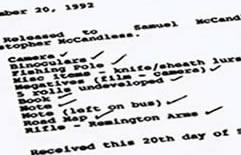 Chris's possessions, released by AK coroner
OPRAH WINFREY: So eating the seed was the fatal—was the fatal blow? From Iconoclasts: The fact that Chris had identification and money with him, as well as this map, does not diminish what he was trying to do that summer of 1992, but the map in particular does raise the question as to why he didn't head south along the bus side of the Tek, and then make use of the Denali park service road as a way over it—once he suspected he was in trouble. Though we can certainly speculate on the reasons, the answer to this question we'll never know for sure. IV. Chris may have sustained a shoulder or arm injury of some kind during his time on the Stampede Trail, perhaps debilitating enough to prevent him from re-crossing the Teklanika River.
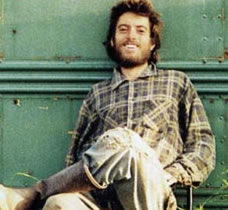 Do you think there's an arm in that sleeve?
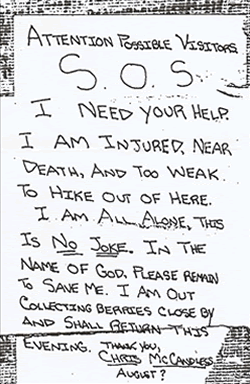 S.O.S. note posted in one of the bus windows
For what it's worth, in the final stages of editing the documentary, we showed this image to a friend in sports medicine who had never heard of Chris McCandless, and who has been treating shoulder injuries for decades. We didn't tell him a word about the film, or the Chris McCandless story, or that we suspected an injury of any sort...but simply asked him to take a look at this photo and tell us what he saw. He said it looked to him like this man had injured his shoulder. |